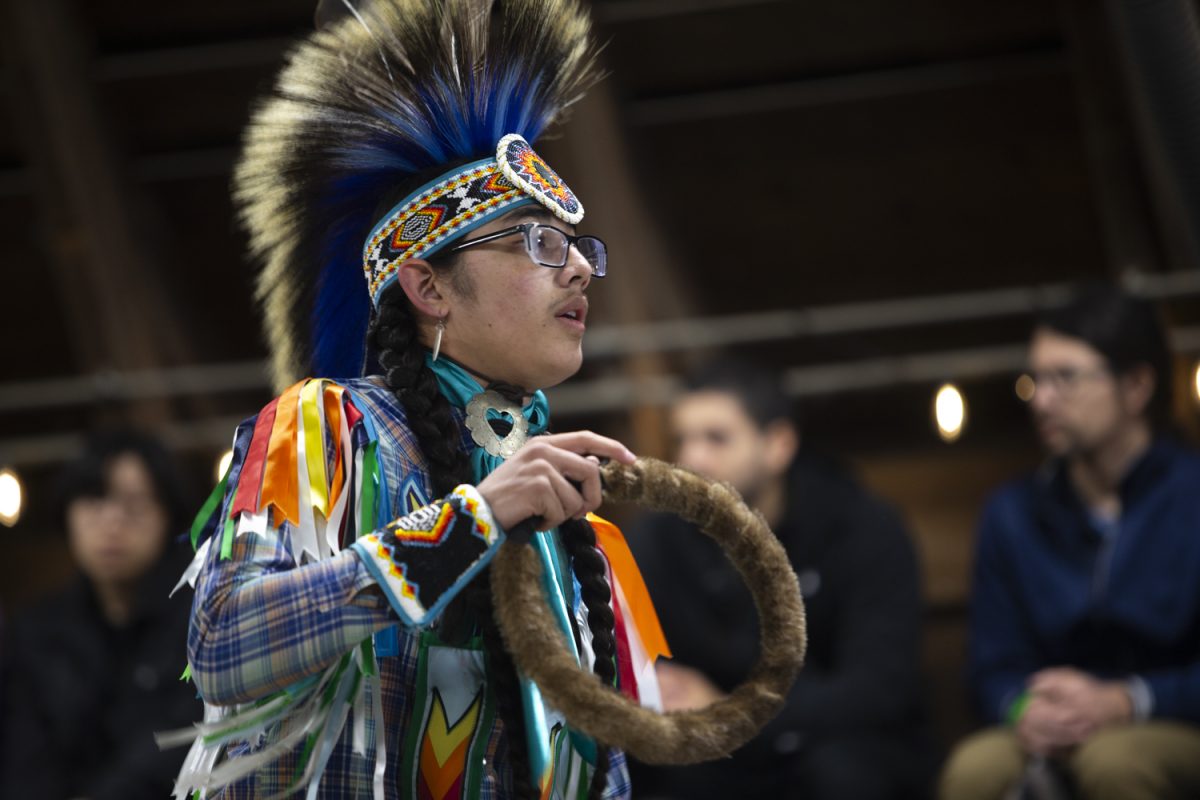Dancers in vibrant regalia, the rhythm of drums, and an enduring sense of tradition and achievement filled the University of Iowa’s 28th Annual Powwow on Saturday at the Johnson County Fairgrounds.
The UI powwow kicked off with the grand entry, a customary opening, where dancers entered the arena in a specific order led by Meskwaki veterans carrying the flags of the Meskwaki Nation, the United States, the State of Iowa, and the POW/MIA. Veterans were honored with a Flag Song as they posted the staffs.
Following the grand entry, student organizers were joined onstage by Vice President for Student Life Sarah Hansen and Associate Vice President and Dean of Students Angie Reams to welcome the crowd packed around the arena.
Singers and drummers from the Meskwaki Nation, Eagle Feather Drum Group, and Big Soldier Creek proceeded with two inter-tribal songs where everyone, including dancers and visitors, was invited to participate.
This was followed by a graduation ceremony in which Adam Potter, a descendant of the Meskwaki Nation and vice president of the UI Native American Council, presented six Indigenous UI fourth-year students with a beaded graduation cap.
“As you embark on the next phase of your journey, I encourage you to remember your roots, ground yourself in the face of adversity drawing strength from your heritage, and use your voices to share your unique stories. Your experiences matter and your perspectives are invaluable,” Potter said, addressing the graduates.
Related: The 26th Annual University of Iowa Powwow, a cultural reconnect after two years
The graduating students were celebrated with an Honor Dance in which they led a procession including the UI powwow’s head dancers as well as the students’ families.
“Honoring individuals who achieve significant milestones has deep roots in Native tradition,” Potter said.
After the graduation ceremony, rounds of dance competitions began, broken into ranks by gender and age. Competitions are another customary element of most powwows, where dancers in full regalia compete in their designated category. Each category of dance, including Traditional, Fancy, Jingle, and Grass, has specific cultural traditions and styles of regalia worn by dancers.
“There are different parts of the regalia that represent different things for different tribes,” said Vern Jefferson, a member of Meskwaki Nation, men’s traditional dancer, and head dancer for the UI powwow.
Jefferson pointed out meaningful pieces of his own regalia handcrafted by his family members.
In an adjacent building at the fairgrounds, a variety of local vendors set up stations offering refreshments and handcrafted beadwork and art by Indigenous creators. The Stanley Center for Peace and Security and local nonprofit Great Plains Action Society offered informational booths.
Alicia Velasquez, of Apache and Yaqui descent, owns the Iowa City jewelry shop The House of Dotł’izhi and participated in the UI powwow as a vendor, as well as a planning committee member tasked with vendor organization.
“This is the most vendors we’ve had,” Velasquez said. “I’ve heard stories from back in the day of so many people and so many vendors at the UI powwow. So my goal is to bring that energy back because I think this is something we really need here in Iowa City.”
Founded in 1990, the UI Annual Powwow enjoyed early success, initially attracting hundreds of attendees and numerous vendors. After organizational challenges led to sporadic scheduling between 2006 and 2014, the UI powwow returned in 2015 with renewed support, continuing its celebration of Indigenous culture in Iowa City.
“We started planning nine months ago, working together with the planning committee and the community to put this event on today,” Jenifer Barajas, this year’s Native American Student Association UI powwow coordinator, said.
The Native American Student Association spearheaded the UI powwow’s planning initiative with assistance from UI’s Native American Council.
“The powwow itself is driven by the Native American Student Association,” Potter, who served as the students’ planning advisor, said.
This year’s UI powwow is only the second since returning from a COVID-19 hiatus, and experienced a remarkably high turnout. Potter emphasized the significance of the event as a cultural celebration for local Indigenous people and a powerful reminder for the community.
“We are on Native land, so the powwow keeps that reminder that the culture is alive, it’s well, and we’re still here,” Potter said.
Abigail Buffalo, president of the Native American Student Association and a member of the Meskwaki Nation, echoed Potter’s sentiment. She said she is proud of the group’s hard work, which brought the UI powwow to life and contributed to its high turnout.
Buffalo highlighted the event’s unique ability to celebrate Indigenous culture and increase the visibility of Native traditions within the community.
“We’re really here to show people that Natives are still here and thriving in the state of Iowa,” Buffalo said.



